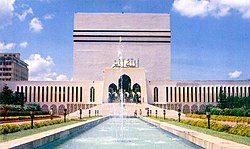Baitul Mukarram
| Baitul Mukarram | |
|---|---|
| বায়তুল মোকাররম | |

|
|
| Basic information | |
| Location | Dhaka, Bangladesh |
| Geographic coordinates | 23°43′46″N 90°24′46″E / 23.7294°N 90.4128°ECoordinates: 23°43′46″N 90°24′46″E / 23.7294°N 90.4128°E |
| Affiliation | Hanafi/Sunni |
| Country | Bangladesh |
| Administration | Islamic Foundation, Bangladesh |
| Year consecrated | 1959 |
| Status | active |
| Ownership | Government of Bangladesh |
| Architectural description | |
| Architect(s) | Abdulhusein M. Thariani |
| Architectural style | Islamic architecture |
| Groundbreaking | 27 January 1960 |
| Completed | 1968 |
| Specifications | |
| Capacity | 40,000 |
| Height (max) | 99 feet |
Baitul Mukarram, also spelled as Baytul Mukarrom (Arabic: بيت المكرّم; Bengali: ; The Holy House) is the national mosque of Bangladesh. Located at the center of Dhaka, capital of Bangladesh, the mosque was completed in 1968. The mosque has a capacity of 30,000, giving it the respectable position of being the 10th biggest mosque in the world. However the mosque is constantly getting overcrowded. This especially occurs during the Islamic holy month of Ramadan, which has resulted in the Bangladeshi government having to add extensions to the mosque, thus increasing the capacity to at least 40,000.
The mosque has several modern architectural features whilst at the same time it preserves the traditional principles of Mughal architecture which has for some time been dominant in the Indian sub-continent. Baitul Mukarram's large cube shape was modeled to that of the Ka'abah at Mecca making it a noticeable structure being unlike any other mosque in Bangladesh.
The mosque is on a very high platform. The Baitul Mukarram Mosque’s building is eight storied and 99 feet high from the ground level. According to the original plan, the main entrance of the mosque was to be on the eastern side. The 'shaan' on the east is 29,000 square feet with ablution space on its south and north sides. Ablution or Wu’du Place cached an important part when the Baitul Mukarram was begun. The absence of a dome on the main building is compensated by the two superficial domed entrance porticoes, one on the south, and the other on the north. The height of these porticoes consists of three rabbit's foot shaped arches, the middle of which is bigger than the rest.
Two patios (roofless inner courtyard) ensure that enough light and air enter the prayer hall of Baitul Mukarram Mosque. The mehrab of the hall is rectangular instead of semi-circular. Excessive ornamentation is avoided throughout the mosque, since minimizing ornamentation is typical of modern architecture.
The garden is laid out in a style borrowed heavily from Mughal gardens, however unlike the traditional Mughal gardens which represent the Islamic Heaven, the garden does not have the Char-Bagh system most likely due to not having enough room for such a garden. The future of this garden is unknown, if the Bangladeshi government extends the mosque, it will most likely have to remove the garden.
...
Wikipedia
